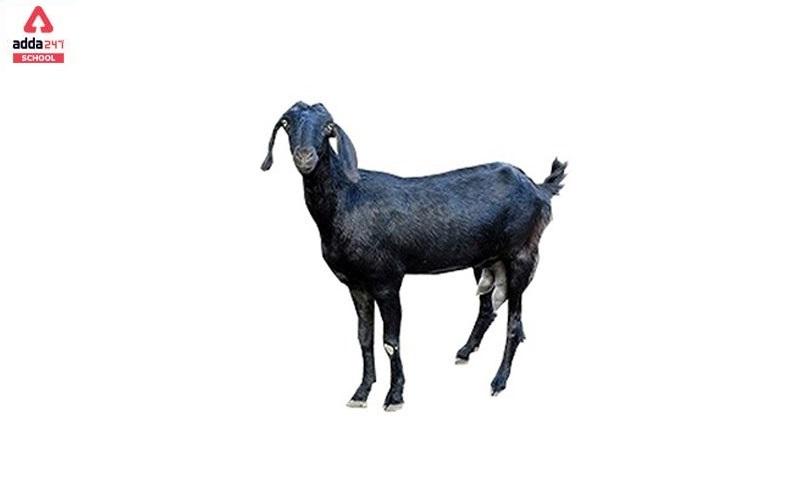The scientific name of goat is Capra Aegagrus Hircus, it is a species of goat antelope. Goats are generally considered domestic animals. They are used for milk and meat. It is kept as livestock for several years. Goat belongs to the Bovidae family. More than 40% of the goat population is found in Asia, China has the highest number of goats followed by India, Pakistan, and Bangladesh. Goat is a ruminant mammal, it is a distinguished vertebra that is identified by the presence of hair or fur in the body and milking glands.
Scientific Name of Goat
The scientific naming of every organism is done by binomial nomenclature. Where the first name is the genus that identifies the family from which the animal belongs and the second part of the name is the identification of the specifications of the family. The scientific name of the goat is Capra Aegagrus Hircus which is the subspecies of the wild Capra aegagrus. Here, Capra is the genus and aegagrus is the species name and circus subspecies. The life expectancy of the goat is between 15 to 18 years. The life expectancy sometimes depends on the conditions the goat lives in. The highest age reported for a goat’s life expectancy was 24 years.
Scientific Name of Goat- Pronunciation
Capra + aegagrus + hircus
Scientific Name of Goat and Sheep in India
Every breed of goat has a little difference but generally, they weigh over 140kg for larger goats, and smaller goat breeds weigh up to 20 to 30 kg.
- Horns- All goats have two horns, which has various size, shape, and color. These characteristics depend on the breed. In some rare cases, polycerate goats get eight horns which is considered a genetic disorder. Horns are a very useful part of goats which are made of protein and keratin. These horns are generally used for defense and dominance among themselves.
- Eyes- Goats have horizontal pupils. This is because their irises are generally pale and are most noticeable than in other castles. Also, goats do not have any tear ducts.
- Digestion- they have a four-chambered stomach, rumen, reticulum, omasum, and abomasum.
- Reproduction- The goats hit puberty at the age of 15, sometimes it depends on the breed. Breeders delay the reproduction process so that the goat can attain the adult weight.
- Diet- Goats generally eat almost everything. They do not eat inedible things, they eat grass, leaves, paper, and sometimes cardboard.
Goat Types
Goats can be classified based on pupils, hair/fur, and breed. There are different kinds of goats, some of them are listed below.
- Cashmere Goat
Origin- Found in the North-eastern part of Asia, like Tibet, Bhutan, Nepal, Ladakh, Myanmar, and Kashmir.
Characteristics- small in size with small horns and large ears.
Habitats- lives normally in colder regions and they generally live in packs
Uses- used for wool, milk, and meat.
- Nubian Goat
Origin- Nubian Goat is a British bred goat which is also called the anglo-Nubian goat.
Characteristics- pricked ears but bred with large lop-eared imported goats.
Habitats- live in a very hot climate
Uses- used for milk and meat
- LaMancha Goat
Origin- found in the USA and is also called American LaMancha.
Characteristics- They have Gopher ears
Habitats- Can survive in normal domestic conditions
Uses- mainly for dairy products
Scientific Name of Goat- बकरी का वैज्ञानिक नाम
प्रत्येक जीव का वैज्ञानिक नामकरण द्विपद नामकरण द्वारा किया जाता है। जहां पहला नाम जीनस है जो उस परिवार की पहचान करता है जिससे जानवर संबंधित है और नाम का दूसरा भाग परिवार की विशिष्टताओं की पहचान है। बकरी का वैज्ञानिक नाम Capra Aegagrus Hircus है जो जंगली Capra aegagrus की उप-प्रजाति है। यहाँ, Capra जीनस है और aegagrus प्रजाति का नाम और सर्कस उप-प्रजाति है। बकरी की जीवन प्रत्याशा 15 से 18 वर्ष के बीच होती है। जीवन प्रत्याशा कभी-कभी उन स्थितियों पर निर्भर करती है जिनमें बकरी रहती है। एक बकरी की जीवन प्रत्याशा के लिए रिपोर्ट की गई उच्चतम आयु 24 वर्ष थी।
Goat Scientific Name in Hindi
कैप्रा + एगग्रस + हिरकस
भारत में एक बकरी और भेड़ का वैज्ञानिक नाम
बकरियों की हर नस्ल में थोड़ा अंतर होता है लेकिन आम तौर पर, बड़ी बकरियों के लिए उनका वजन 140 किलोग्राम से अधिक होता है, और छोटी बकरी की नस्लों का वजन 20 से 30 किलोग्राम तक होता है।
सींग- सभी बकरियों के दो सींग होते हैं, जो विभिन्न आकार, आकार और रंग के होते हैं। ये विशेषताएं नस्ल पर निर्भर करती हैं। कुछ दुर्लभ मामलों में, पॉलीसेरेट बकरियों में आठ सींग होते हैं जिन्हें आनुवंशिक विकार माना जाता है। सींग बकरियों का एक बहुत ही उपयोगी हिस्सा हैं जो प्रोटीन और केराटिन से बने होते हैं। ये सींग आम तौर पर आपस में रक्षा और प्रभुत्व के लिए उपयोग किए जाते हैं।
आंखें- बकरियों की पुतली क्षैतिज होती है। ऐसा इसलिए है क्योंकि उनके आईरिस आमतौर पर पीले होते हैं और अन्य महल की तुलना में सबसे अधिक ध्यान देने योग्य होते हैं। साथ ही, बकरियों में आंसू नलिकाएं नहीं होती हैं।
पाचन- इनका पेट चार-कक्षीय होता है, रुमेन, रेटिकुलम, ओमासम और एबोमासम।
प्रजनन- बकरियां 15 साल की उम्र में यौवन पर आ जाती हैं, कभी-कभी यह नस्ल पर निर्भर करती है। ब्रीडर्स प्रजनन प्रक्रिया में देरी करते हैं ताकि बकरी वयस्क वजन प्राप्त कर सके।
आहार- बकरियां आमतौर पर लगभग सब कुछ खाती हैं। वे अखाद्य चीजें नहीं खाते हैं, वे घास, पत्ते, कागज और कभी-कभी कार्डबोर्ड खाते हैं।
बकरी का वैज्ञानिक नाम: प्रकार
बकरियों को विद्यार्थियों, बाल/फर और नस्ल के आधार पर वर्गीकृत किया जा सकता है। बकरियां विभिन्न प्रकार की होती हैं, उनमें से कुछ नीचे सूचीबद्ध हैं।
कश्मीरी बकरी
उत्पत्ति- एशिया के उत्तर-पूर्वी भाग जैसे तिब्बत, भूटान, नेपाल, लद्दाख, म्यांमार और कश्मीर में पाई जाती है।
विशेषताएँ- छोटे सींग और बड़े कानों के साथ आकार में छोटा।
पर्यावास- सामान्य रूप से ठंडे क्षेत्रों में रहते हैं और वे आम तौर पर पैक्स में रहते हैं
उपयोग- ऊन, दूध और मांस के लिए उपयोग किया जाता है।
न्युबियन बकरी
उत्पत्ति- न्युबियन बकरी एक ब्रिटिश नस्ल की बकरी है जिसे एंग्लो-न्यूबियन बकरी भी कहा जाता है।
विशेषताएं- चुभने वाले कान लेकिन बड़े लोप-कान वाली आयातित बकरियों के साथ नस्ल।
पर्यावास- बहुत गर्म जलवायु में रहते हैं
उपयोग- दूध और मांस के लिए उपयोग किया जाता है
लामांचा बकरी
उत्पत्ति- संयुक्त राज्य अमेरिका में पाया जाता है और इसे अमेरिकी लामांचा भी कहा जाता है।
विशेषताएं- इनके गोफर कान होते हैं
पर्यावास- सामान्य घरेलू परिस्थितियों में जीवित रह सकते हैं
उपयोग- मुख्य रूप से डेयरी उत्पादों के लिए
Related Post:
- Father Of Economics- Adam Smith
- Who Was The Last Viceroy Of India?
- Planck’s Constant- Value, Definition, Unit, Symbol, Formula
- Bohr Atomic Model- Diagram, Formula, Postulates And Limitations
- Median Formula For Even, Odd, And Grouped Data
- The Largest Country In The World By Area & Population
- Value Of E In Maths And Physics
- 17 National Symbol Of India With Names List
- Father Of Mathematics In India And World
- IPPB Full Form – India Post Payments Bank
Scientific Name of Goat QNAs
1. What is the scientific name of a domestic goat?
Ans. Capra reverses Linnaeus as the name of the domestic goat. It is a subspecies of C.aegagrus. It is a member of the animal family Bovidae and the subfamily Caprinae, which is closely related to sheep.
2. What are the different types of goats?
Ans. Female goats are referred to as does and nannies and males are called bucks and billies. The juvenile goats of both sexes are called kids.
3. What is the origin of the word goat?
Ans. In ancient times, the goat was referred to as bucca, hegoote in the late 12 century, and nannies in the 18th century. Billy goats originate in the 19th century.









 Bihar Board Dummy Registration Card 2026...
Bihar Board Dummy Registration Card 2026...
 SGBAU Result 2025 Out @sgbau.ucanapply.c...
SGBAU Result 2025 Out @sgbau.ucanapply.c...
 UUCMS Login Result 2025 Out at uucms.kar...
UUCMS Login Result 2025 Out at uucms.kar...










